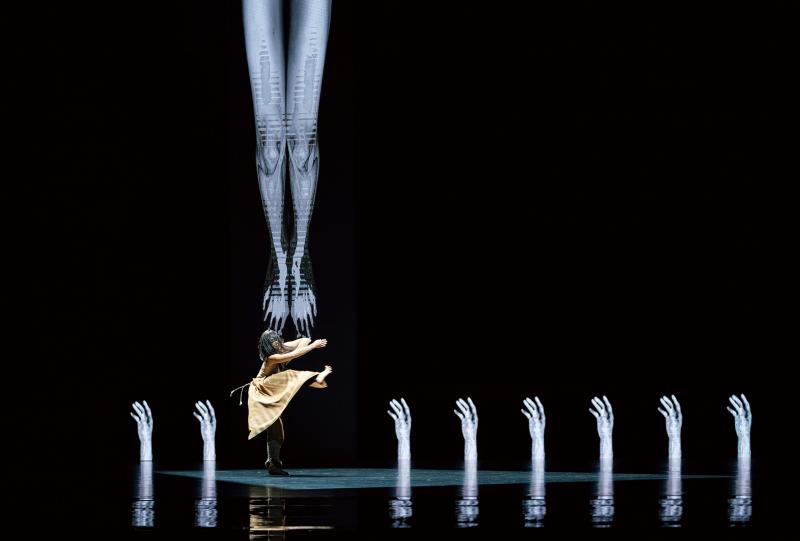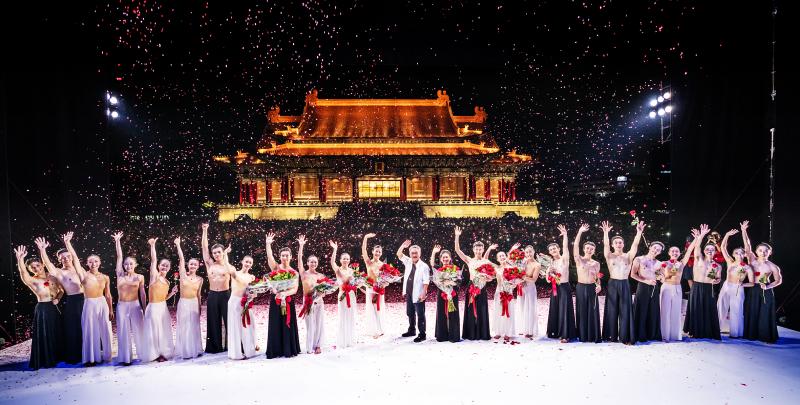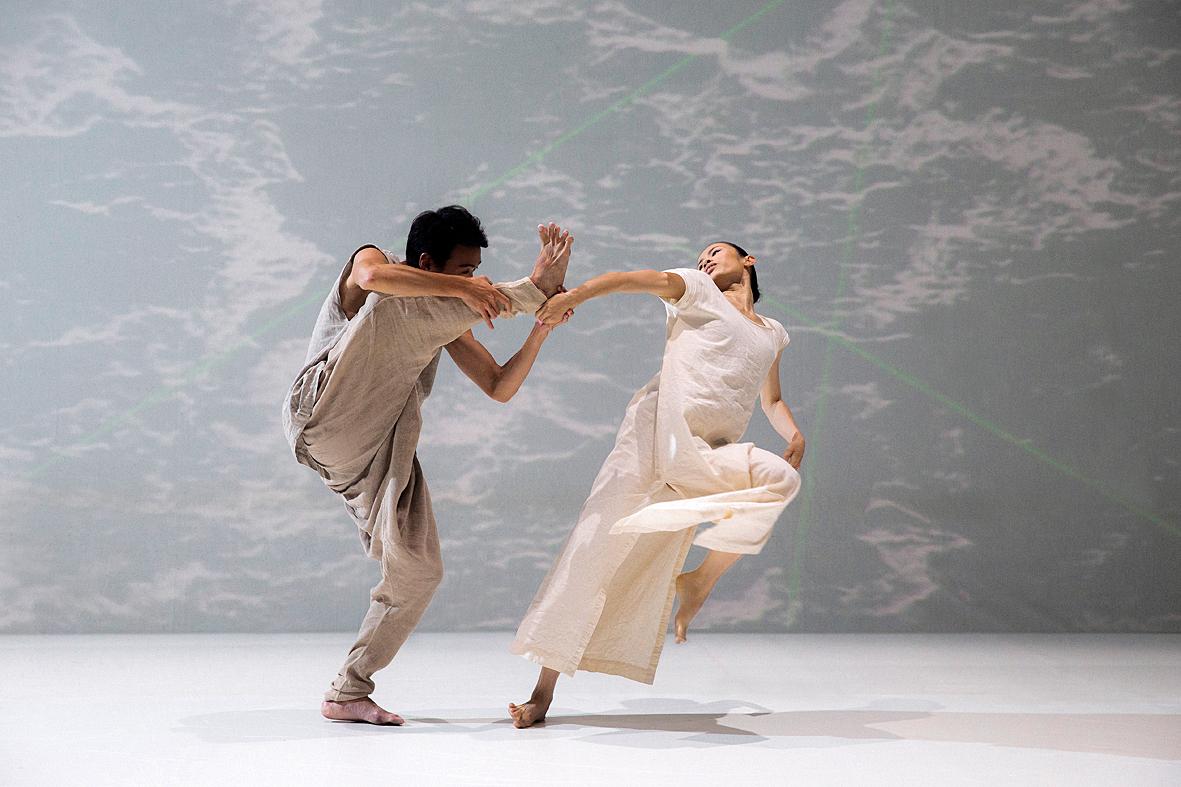Like so many other rites of passage that have fallen by the wayside in this COVID-19 ravaged year, Cloud Gate Dance Theatre of Taiwan’s (雲門舞集) traditional summertime outdoor performances at Taipei’s Liberty Plaza and elsewhere around the nation have been canceled.
It is not that Cloud Gate and its long-time sponsor Cathay Financial Holdings did not believe that they could run a tightly organized show tomorrow night with audience members seated in appropriate social distancing arrangements for what would have been their 25th annual Cathay Arts Festival production.
They were certainly not anticipating a crowd of the size of the 50,000 that showed up on July 27 last year for the 45th Anniversary Gala Program to have a chance to see several senior dancers who were going to be retiring along with company founder and artistic director Lin Hwai-min (林懷民) at the end of last year — or even the 20,000 to 30,000 who have shown up in previous years.

Photo courtesy of Chang Chen-chou
With their well-trained staff and volunteers, Cloud Gate and Cathay Financial could have kept track of who was seated where, just as theaters have been doing for indoor performances, with audience members providing contact information, but the concern was about the people who would be milling about on the fringes of the seating area.
So the decision was made to turn this year’s festival into a digital premier, not of just one production, but two, and not just in Taiwan, but globally.
Starting tomorrow night at 8pm (GMT+8) via Cloud Gate’s, Cathay’s and the Public Television Service’s (PTS) YouTube channels, Lunar Halo (毛月亮), created for Cloud Gate 2 (雲門 2) by its then-artistic director Cheng Tsung-lung (鄭宗龍) will air, followed by Lin Hwai-min: A Retrospective.

Photo courtesy of Liu Chen-hsiang
While Cheng’s Lunar Halo will only be available for 24 hours, the Lin retrospective will remain online for seven days, until Saturday next week at 8pm.
Lunar Halo is an apt choice for a digital audience, as it explores human existence in an ever-changing digital world, questioning the need for physical bodies and senses when so many people now rely on their eyes and fingertips to experience games, films and the world.
Set to an ethereal soundtrack by Icelandic post-rock band Sigur Ros, the dancers move through a landscape of human body parts and color projections, presented on three massive LED screens through the technical and creative wizardry of visual designer Jam Wu (吳耿禎) and videographer Ethan Wang (王奕盛).

Photo courtesy of Liu Chen-hsiang
The dancers morph along with the video projections, creating beautiful images that are often equally intellectually and emotionally challenging.
Lunar Halo is also a good introduction to Cheng, Lin’s successor as Cloud Gate artistic director, for those who have not seen his work for Cloud Gate 2 and other companies. It also serves as a preview of his first full-length production for the reformatted company, Sounding Light (定光), which premieres Oct. 1 at the National Theater before going on tour to Kaohsiung and Taichung.
The Lin retrospective is basically the 45th Anniversary Gala Program, which premiered at the National Theater in November 2018, featuring the company’s dancers in some of their favorite roles of the past two decades, including 1997’s Portrait of the Families (家族合唱), 1998’s Moon Water (水月), 2001’s Cursive (行草) and Bamboo Dream (竹夢), 2006’s Wind Shadow (風.影) and 2013’s Rice (稻禾).
The programs can be viewed on Cloud Gate’s YouTube channel (cloudgate2020.piee.pw/T6HQ9), the troupe’s Vimeo (cloudgate2020.pse.is/SVG79), Cathay Financial’s YouTube channel(cathaylifecloudgate.piee.pw/QWSF4) and PTS’ YouTube channel (lihi1.com/xRejF).
Meanwhile, the second half of the Cathay Arts Festival — Dancing with Cloud Gate — will be held on weekends from Aug. 1 to Aug. 30, in Taoyuan, Hsinchu, Chiayi and Pingtung, and on Friday, Sept. 4 in Taitung.
Curated by Cheng, the program is designed to break down the barriers between performers and audiences by allowing people to interact with the company’s dancers in a variety of public spaces.
Admission is free, but limited due to safety issues and space restrictions. Advanced registration is required for all performances except for those in Chiayi.
More information is available in Mandarin and English on Cloud Gate’s Web site (www.cloudgate.org.tw).

This is the year that the demographic crisis will begin to impact people’s lives. This will create pressures on treatment and hiring of foreigners. Regardless of whatever technological breakthroughs happen, the real value will come from digesting and productively applying existing technologies in new and creative ways. INTRODUCING BASIC SERVICES BREAKDOWNS At some point soon, we will begin to witness a breakdown in basic services. Initially, it will be limited and sporadic, but the frequency and newsworthiness of the incidents will only continue to accelerate dramatically in the coming years. Here in central Taiwan, many basic services are severely understaffed, and

It is a soulful folk song, filled with feeling and history: A love-stricken young man tells God about his hopes and dreams of happiness. Generations of Uighurs, the Turkic ethnic minority in China’s Xinjiang region, have played it at parties and weddings. But today, if they download it, play it or share it online, they risk ending up in prison. Besh pede, a popular Uighur folk ballad, is among dozens of Uighur-language songs that have been deemed “problematic” by Xinjiang authorities, according to a recording of a meeting held by police and other local officials in the historic city of Kashgar in

Jan. 5 to Jan. 11 Of the more than 3,000km of sugar railway that once criss-crossed central and southern Taiwan, just 16.1km remain in operation today. By the time Dafydd Fell began photographing the network in earnest in 1994, it was already well past its heyday. The system had been significantly cut back, leaving behind abandoned stations, rusting rolling stock and crumbling facilities. This reduction continued during the five years of his documentation, adding urgency to his task. As passenger services had already ceased by then, Fell had to wait for the sugarcane harvest season each year, which typically ran from

The People’s Republic of China (PRC) was out in force in the Taiwan Strait this week, threatening Taiwan with live-fire exercises, aircraft incursions and tedious claims to ownership. The reaction to the PRC’s blockade and decapitation strike exercises offer numerous lessons, if only we are willing to be taught. Reading the commentary on PRC behavior is like reading Bible interpretation across a range of Christian denominations: the text is recast to mean what the interpreter wants it to mean. Many PRC believers contended that the drills, obviously scheduled in advance, were aimed at the recent arms offer to Taiwan by the